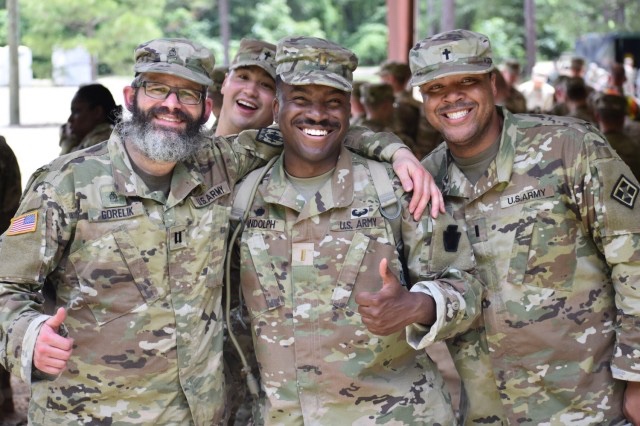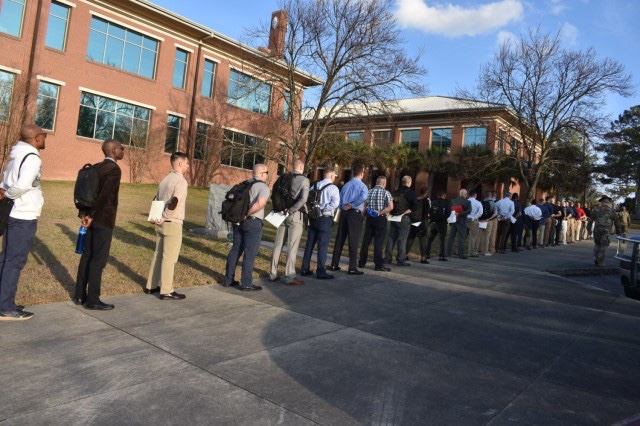
The first Chaplain Basic Officer Leader Course of the year, Class 23-001 began at the Army Institute for Religious Leadership, Jan. 19.
The students come from different locations, backgrounds and faith groups. The diversity of the students plays a major role in providing religious service support to Soldiers and their Families.
Soldiers and their Families represent a cross-section of America. The Army Chaplain Corps seeks chaplains and religious affairs specialists who can meet the needs of this diverse population and care for the soul of America’s Army.
It is not always an easy task to match the diversity of the Army population with members of the clergy, but it is a major part of the recruiting effort to try.
“The military focus on diversity, equity and inclusion helps to capture the full landscape of our diverse culture. One dimension of the military culture is a person’s faith as it relates to spirituality and their religious beliefs,” said Chaplain (Col.) Monica Lawson, chief, Recruiting and Accessions Division – Office of the Chief of Chaplains. “In order to assist in our chaplain recruiting efforts we are looking for called and qualified applicants who also represent the diversity of the Army population.”

There are three CHBOLC classes each year. A look at the three CHBOLC classes in 2022 tells a story of how it is going.
At a glance, there were 78 students in class 22-001, 86 students in class 22-002 and 82 students in class 22-003. CHBOLC 23-001 begins with 75 students.
Males’ makeup most students with 70 males in class 22-001, 77 in class 22-002 and 73 in class 22-003 with ranges of 20-59 years of age. Chaplain candidates tend to be older due the requirement to complete seminary and hold a master’s degree. Younger applicants who apply for the Chaplain Candidate Program are able to attend CHBOLC while going through seminary and working on their master’s degree. The age requirement for the Chaplain Candidate Program is less than age of 37 unless a waiver is granted.
Candidates are mixed racially and ethnically. Caucasians are the largest group followed by African Americans, Asian, Hispanic and others. They represent future active duty, Reserve and National Guard appointments. Some have prior military service as officers or enlisted in various specialties.
The faith traditions the Army recognizes for training as Army Chaplains include Christian, Muslim, Jewish, Hindu and Buddhist. Christian is the largest group, but also represent many denominations.
Candidates are associated with an endorser organization within different faith groups. Many faith groups don’t allow females to become clergy which partially accounts for the lower number of female candidates. Female chaplains are part of an underrepresented group that the Chaplain Corps is working to grow. Underrepresented faith groups include Muslims, Hindu, Buddhist and Catholics.
The Chaplain Corps introduced Every Chaplain Corps Member a Recruiter Initiative to address the low numbers across the corps and among the underrepresented groups.
“We need to recruit the next generation of chaplains today. We need chaplains who are passionate about caring for the souls of Soldiers and their Families, and who can operate effectively in a pluralistic environment,” said Chaplain (Maj. Gen.) Thomas L. Solhjem, chief of chaplains.
The goal is to transition civilian clergy of different faith traditions into Chaplains who will take on the charge of caring for the souls of America’s Army.
“‘The mission of the Initial Military Training Division is to provide education and training to newly accessioned chaplains and religious affairs specialists that enables graduates to perform the function as a Unit Ministry Team.’ The training enforces the Army standard and welcomes all people of all backgrounds,” said IMT Division Chief, Chaplain (Lt. Col.) William M. Oliver.
There are minimum requirements to request entry into the Army chaplaincy.
One must possess a bachelor’s degree from an accredited university or are a current graduating college senior, secure an endorsement for military service from one’s faith group and enroll or get accepted as a full-time student in an accredited graduate program that qualifies one for ordination.
The core responsibilities of a chaplain are to nurture the living, care for the wounded and honor the dead. This includes Soldiers, Family members and Department of the Army Civilians. In a diverse organization with many beliefs, this may require coordination among UMTs. When chaplains encounter those of another faith group, they work to find a chaplain of that faith group to provide religious service support to the Soldier or Family member.
This is known as perform or provide.
“That’s the strength of our Chaplaincy. We care for everybody,” said Deputy Chief of Chaplains, Chaplain (Brig. Gen.) Bill Green. “When the four chaplains had to give away their life jackets, they weren’t looking for their particular faith group to give their life jackets to. They saw another person. They honored the life of that person and as a result of that they gave their jacket away and made the ultimate sacrifice. They died.”
Once an individual has accepted the call to serve as an Army Chaplain, they would need to follow the steps outlined on the www.goarmy.com/careers-and-jobs/specialty-careers/chaplain webpage.
By Mel Slater, Institute for Religious Leadership


Diversity that serves the DOD population? I don’t see any Asatro, Rastafarian, or Flying Spaghetti Monster chaplains listed.